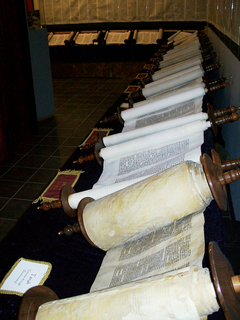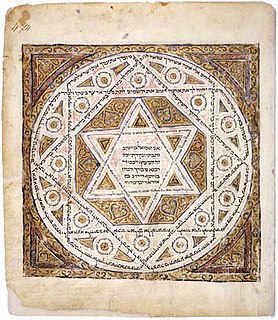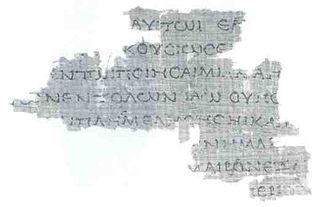Related Research Articles

The Greek Old Testament, or Septuagint, is the earliest extant Koine Greek translation of books from the Hebrew Bible, various biblical apocrypha, and deuterocanonical books. The first five books of the Hebrew Bible, known as the Torah or the Pentateuch, were translated in the mid-3rd century BCE; they did not survive as original-translation texts, however, except as rare fragments. The remaining books of the Greek Old Testament are presumably translations of the 2nd century BCE.

The Hebrew Bible, which is also called the Tanakh, or sometimes the Miqra (מִקְרָא), is the canonical collection of Hebrew scriptures, including the Torah. These texts are almost exclusively in Biblical Hebrew, with a few passages in Biblical Aramaic. The form of this text that is authoritative for Rabbinic Judaism is known as the Masoretic Text (MT) and consists of 24 books, while Protestant Bibles divide essentially the same material into 39 books. Catholic Bibles and Eastern / Greek Orthodox Bibles contain additional materials in their Old Testaments, derived from the Septuagint and other sources.

The Vulgate is a late-4th-century Latin translation of the Bible. It was to become the Catholic Church's officially promulgated Latin version of the Bible during the 16th century and is still used in the Latin Church alongside the Hebrew and Greek sources.

The Masoretic Text is the authoritative Hebrew Aramaic text of the 24 books of the Tanakh in Rabbinic Judaism. The Masoretic Text defines the Jewish canon and its precise letter-text, with its vocalization and accentuation known as the masorah. It was primarily copied, edited and distributed by a group of Jews known as the Masoretes between the 7th and 10th centuries of the Common Era (CE).

Textual criticism is a branch of textual scholarship, philology, and of literary criticism that is concerned with the identification of textual variants, or different versions, of either manuscripts or of printed books. Such texts may range in dates from the earliest writing in cuneiform, impressed on clay, for example, to multiple unpublished versions of a 21st-century author's work. Historically, scribes who were paid to copy documents may have been literate, but many were simply copyists, mimicking the shapes of letters without necessarily understanding what they meant. This means that unintentional alterations were common when copying manuscripts by hand. Intentional alterations may have been made as well, for example the censoring of printed work for political, religious or cultural reasons.

Biblical studies is the academic application of a set of diverse disciplines to the study of the Bible. For its theory and methods, the field draws on disciplines ranging from archaeology, ancient history, cultural anthropology, textual criticism, literary criticism, historical backgrounds, mythology, and comparative religion.
The New Jerusalem Bible (NJB) is an English-language translation of the Bible published in 1985 by Darton, Longman and Todd and Les Editions du Cerf, edited by Henry Wansbrough and approved for use in study and personal devotion by Roman Catholics.

The Leningrad Codex is the oldest complete manuscript of the Hebrew Bible in Hebrew, using the Masoretic Text and Tiberian vocalization. It is dated 1008 CE according to its colophon. The Aleppo Codex, against which the Leningrad Codex was corrected, is several decades older, but parts of it have been missing since 1947, making the Leningrad Codex the oldest complete codex of the Tiberian mesorah that has survived intact to this day.

Hexapla is the term for a critical edition of the Hebrew Bible in six versions, four of them translated into Greek, preserved only in fragments. It was an immense and complex word-for-word comparison of the original Hebrew Scriptures with the Greek Septuagint translation and with other Greek translations. The term especially and generally applies to the edition of the Old Testament compiled by the theologian and scholar Origen, sometime before 240.

The Biblia Hebraica Stuttgartensia, abbreviated as BHS or rarely BH4, is an edition of the Masoretic Text of the Hebrew Bible as preserved in the Leningrad Codex, and supplemented by masoretic and text-critical notes. It is the fourth edition in the Biblia Hebraica series started by Rudolf Kittel and is published by the Deutsche Bibelgesellschaft (German Bible Society) in Stuttgart.

Novum Testamentum Graece is a critical edition of the New Testament in its original Koine Greek, forming the basis of most modern Bible translations and biblical criticism. It is also known as the Nestle-Aland edition after its most influential editors, Eberhard Nestle and Kurt Aland. The text, edited by the Institute for New Testament Textual Research, is currently in its 28th edition, abbreviated NA28.

Biblia Hebraica refers primarily to the three editions of the Hebrew Bible edited by Rudolf Kittel. When referenced, Kittel's Biblia Hebraica is usually abbreviated BH, or BHK. When specific editions are referred to, BH1, BH2 and BH3 are used. Biblia Hebraica is a Latin phrase meaning Hebrew Bible, traditionally used as a title for printed editions of the Tanakh. Less commonly, Biblia Hebraica may also refer to subsequent editions in the Biblia Hebraica series which build on the work of Kittel's editions.

The Biblia Hebraica Quinta Editione, abbreviated as BHQ or rarely BH5, is the fifth edition of the Biblia Hebraica and when complete will supersede the fourth edition, the Biblia Hebraica Stuttgartensia (BHS).

Emanuel Tov is emeritus Professor in the Department of Bible at the Hebrew University of Jerusalem.

The New English Translation of the Septuagint and the Other Greek Translations Traditionally Included under That Title (NETS) is a modern translation of the Septuagint (LXX), that is the scriptures used by Greek-speaking Christians and Jews of antiquity. The translation was sponsored by the International Organization for Septuagint and Cognate Studies (IOSCS). The Psalms were published in 2000 and the complete Septuagint in 2007.
The Hebrew University Bible Project (HUBP) is a project at the Hebrew University of Jerusalem to create the first edition of the Hebrew Bible that reproduces the text of the Aleppo Codex and includes a thorough critical apparatus.
The Common English Bible (CEB) is an English translation of the Bible whose language is intended to be at a comfortable reading level for the majority of English readers. The translation was begun in late 2008 and was finished in 2011. It includes the deuterocanonical books, or apocrypha, which are found in the Catholic Church and Orthodox Church canons, and in Anglican Bibles.

Papyrus Fouad 266 is a copy of the Pentateuch in the Greek version of the Hebrew Bible known as the Septuagint. It is a papyrus manuscript in scroll form. The manuscript has been assigned palaeographically to the 1st century BC. The manuscript has survived in a fragmentary condition. Discussion about this manuscript questions whether it is or is not a later recension of the standard Septuagint text.

The manuscript 4Q120 is a Septuagint manuscript (LXX) of the biblical Book of Leviticus, found at Qumran. The Rahlfs-No. is 802. Palaoegraphycally it dates from the first century BCE. Currently the manuscript is housed in the Rockefeller Museum in Jerusalem.
The Literal English Version of Scripture (LEV) is a translation of the Bible, based on the World English Bible. Formerly known as the "Shem Qadosh Version" the title was officially changed in November 2016. It is considered a Sacred Name Bible rendering the name of God using the Hebrew characters יהוה, and that of Jesus in Hebrew as ישוע. It was created by a team of volunteers across the United States with additional proofing and editing assistance by individuals in Poland and Taiwan. Footnotes and appendices were written by the General Editor, J. A. Brown.
References
- ↑ Fox (2006), p. 4.
- ↑ Hendel (2008), pp. 325 & 236.
- ↑ See Williamson (2009), Tigchelaar (2012), and Tov (2012) for criticisms of the project.
- ↑ Hendel (2013).
- ↑ Fox, Michael V. (2015). Proverbs: An Eclectic Edition with Introduction and Textual Commentary. Atlanta: SBL Press. ISBN 9781628370201.
- ↑ "April 8, 2015 Newsletter". Society of Biblical Literature. Retrieved 20 September 2015.
- ↑ Samples of the Oxford Hebrew Bible (in PDF format) , accessed September 20, 2015.
Sources
- Fox, M. V., "Editing Proverbs: The Challenge of the Oxford Hebrew Bible", Journal of Northwest Semitic Languages, vol. 32, no. 1 (2006), pp. 1–22.
- Hendel, R., "The Oxford Hebrew Bible: Prologue to a New Critical Edition", Vetus Testamentum, vol. 58, no. 3 (2008). pp. 324–51.
- Hendel, R., "The Oxford Hebrew Bible: Its Aims and a Response to Criticisms." Hebrew Bible and Ancient Israel, vol. 2, no. 1 (forthcoming, 2013). Preprint at .
- Tigchelaar, E., "Editing the Hebrew Bible: An Overview of Some Problems" in Kloppenborg & Newman (eds.), Editing the Bible: Assessing the Task Past and Present (Atlanta: SBL, 2012).
- Tov, E., Textual Criticism of the Hebrew Bible (3rd edition) (Minneapolis: Fortress Press, 2012).
- Williamson, H. G. M., "Do We Need a New Bible? Reflections on the Proposed Oxford Hebrew Bible", Biblica vol. 90, no. 2 (2009), pp. 164–167.